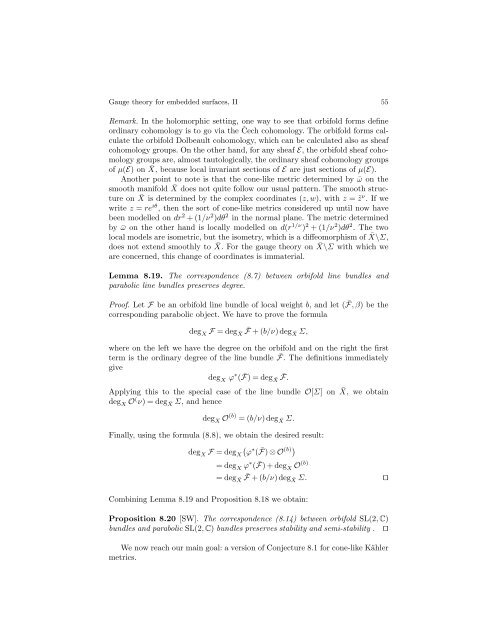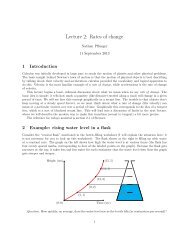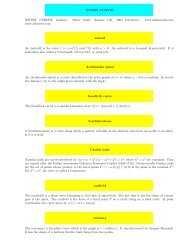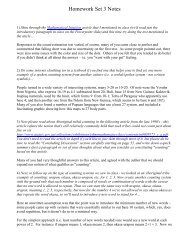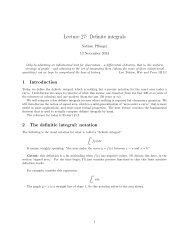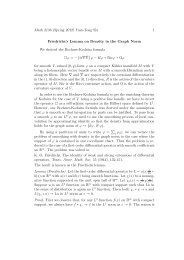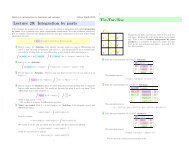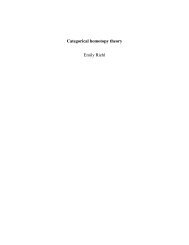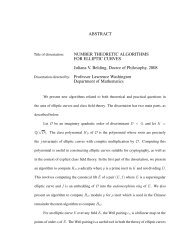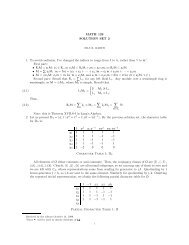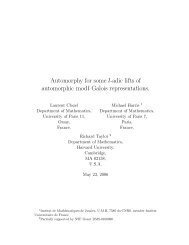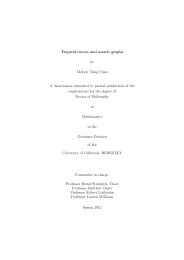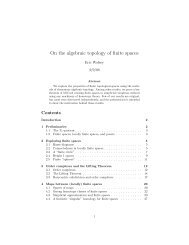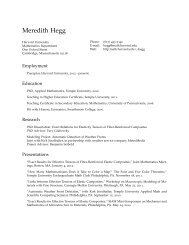Gauge theory for embedded surfaces, II
Gauge theory for embedded surfaces, II
Gauge theory for embedded surfaces, II
You also want an ePaper? Increase the reach of your titles
YUMPU automatically turns print PDFs into web optimized ePapers that Google loves.
<strong>Gauge</strong> <strong>theory</strong> <strong>for</strong> <strong>embedded</strong> <strong>surfaces</strong>, <strong>II</strong> 55<br />
Remark. In the holomorphic setting, one way to see that orbifold <strong>for</strong>ms define<br />
ordinary cohomology is to go via the Čech cohomology. The orbifold <strong>for</strong>ms cal-<br />
culate the orbifold Dolbeault cohomology, which can be calculated also as sheaf<br />
cohomology groups. On the other hand, <strong>for</strong> any sheaf E, the orbifold sheaf cohomology<br />
groups are, almost tautologically, the ordinary sheaf cohomology groups<br />
of µ(E) on ¯ X, because local invariant sections of E are just sections of µ(E).<br />
Another point to note is that the cone-like metric determined by ¯ω on the<br />
smooth manifold ¯ X does not quite follow our usual pattern. The smooth structure<br />
on ¯ X is determined by the complex coordinates (z,w), with z =˜z ν .Ifwe<br />
write z = re iθ , then the sort of cone-like metrics considered up until now have<br />
been modelled on dr 2 +(1/ν 2 )dθ 2 in the normal plane. The metric determined<br />
by ¯ω on the other hand is locally modelled on d(r 1/ν ) 2 +(1/ν 2 )dθ 2 .Thetwo<br />
local models are isometric, but the isometry, which is a diffeomorphism of ¯ X\Σ,<br />
does not extend smoothly to ¯ X. For the gauge <strong>theory</strong> on ¯ X\Σ with which we<br />
are concerned, this change of coordinates is immaterial.<br />
Lemma 8.19. The correspondence (8.7) between orbifold line bundles and<br />
parabolic line bundles preserves degree.<br />
Proof. Let F be an orbifold line bundle of local weight b, and let ( ¯ F,β)bethe<br />
corresponding parabolic object. We have to prove the <strong>for</strong>mula<br />
deg X F =deg¯ X ¯ F+(b/ν)deg¯X Σ,<br />
where on the left we have the degree on the orbifold and on the right the first<br />
term is the ordinary degree of the line bundle ¯ F. The definitions immediately<br />
give<br />
degX ϕ ∗ ( ¯ F)=deg¯¯ XF. Applying this to the special case of the line bundle O[Σ] on ¯ X, we obtain<br />
degX O ( ν)=deg¯ XΣ, and hence<br />
deg X O (b) =(b/ν)deg ¯ X Σ.<br />
Finally, using the <strong>for</strong>mula (8.8), we obtain the desired result:<br />
∗<br />
degX F =degXϕ( F)⊗O ¯ (b) <br />
=degXϕ ∗ ( ¯ F)+degXO (b)<br />
=deg¯ X ¯ F+(b/ν)deg¯X Σ. ⊓⊔<br />
Combining Lemma 8.19 and Proposition 8.18 we obtain:<br />
Proposition 8.20 [SW]. The correspondence (8.14) between orbifold SL(2, C)<br />
bundles and parabolic SL(2, C) bundles preserves stability and semi-stability . ⊓⊔<br />
We now reach our main goal: a version of Conjecture 8.1 <strong>for</strong> cone-like Kähler<br />
metrics.


